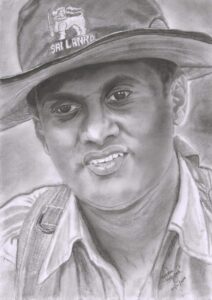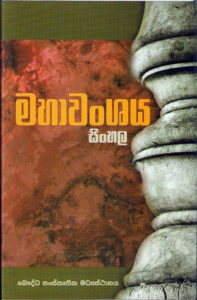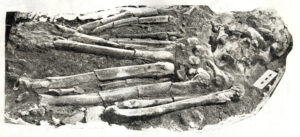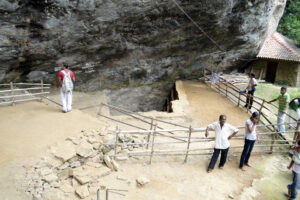Chandima Bandara Ambanwala
Department of Archaeology & Heritage Management, Rajarata University of Sri Lanka, Mihintale.
chandimaambanwala@yahoo.com
Translated by: Chryshane Mendis

Introduction
Sri Lanka stands out as one of the foremost among the few countries in the world with a continuous written history. Since the introduction of Buddhism from India, Buddhist scholars keen on writing down the history of the Sasana had written the Deepavamsa, Mahavamsa, and various other chronicles and literature continuously from the 3rd century BC up to the present.  The main aim of the early literature was to record the history of the Sasana in the island thus the recording of human settlements did not seem important to the writer. According to the great Chronicle Mahavamsa, the human habitation of the island called Lanka took place with the arrival of Prince Vijaya. Accordingly, most scholars of history believe the island was made a human settlement with the arrival of immigrants from North India speaking an Aryan language around the 5th century BC. Prof.Senerath Paranavitana believed the pioneers for the cultivation of Indo-Aryan settlers were Traders. Certain scholars also suggest that the island was colonized by the Tamils who made South India their homeland. But historical and archaeological investigations have provided little evidence to prove this theory. There are also other theories on the human colonization of the island but are neglected due to the lack of a strong basis for them.

By the time of Emperor Ashoka of India, the Sinhalese who had come from North India speaking an Aryan language had by this time settled in many parts of the island and begun agriculture, farming, industries, and trade for their living and had developed their lifestyle to a considerable level. From this background, the history of Sri Lanka could be revealed from local and foreign sources. Taking it simply, before Sri Lanka was settled by immigrants from North India, was the island inhabited? Or according to the Mahavamsa and North Indian literary sources such as the Divyavadana, Sinhalavadana was the island inhabited by supernatural people who could change their form as they wished? During the past 125 years due to the limitless efforts of both local and foreign scholars, these questions have been answered to a considerable extent by Archaeologists and other experts. But the knowledge generated from such studies has mostly been limited due to it either being in English or being introduced only to Archaeology (Special) students in Universities. This knowledge, created by the usage of public funds for the discovery of the past of our people and not being made known to the general public is a matter of concern. There is a great need for the study of the prehistory of Sri Lanka to be made known to the society as the prehistoric man being not only the ancestor of our people but also forming the base for the formation of our proud history.
There is little opportunity for the school students to study the story of the prehistoric man who made his home in the island more than 2500 years ago. Â There is even less opportunity for the general public in this regard. Through this article, I hope to give a brief introduction to the story of the prehistoric man of Sri Lanka who lived thousands of years ago and how our ancestors interacted with the environment for their survival. The continuing of an academic work on the internet needs comments from readers. Hence kindly note that the continuing of this article series depends on the positive and negative feedback received.
History and Prehistory
In the study of human history, if a time period could be studied using written records or literary sources, it could be considered as History. Scholars in general state that the written evidence in Sri Lanka starts from the 3rd century BC. It is believed that the Brahmi script used by Emperor Ashoka in his letters of the Dharma was introduced to the island with the arrival of the Most Ven. Mahinda and thus the people learnt the art of recording. As these incidents took place in the 3rd century BC, it is accepted that the written records start from around that period. (But Dr. Siran Deraniyagala has been able to rationally prove that the use of script in the island dates back 2-3 centuries prior). Inscriptions using such script can be found in the thousands throughout the island on rock shelters offered to monks. Some of the best examples of these can be found in Anuradhapura from sites such as Mihinthale, Vessagiriya, and also in Sithulpavva. As said before, it is accepted that these inscriptions belong to the 3rd century or later and through these inscriptionsPalaeolithicwe could get a good understanding of our history. Accordingly, the period from the writing of such inscriptions up unto the present can be stated as History or the Historic period.

As such the period before writing or the period before the historic period is known as the Prehistoric period. Though the Deepavamsa, Mahavamsa and other literary sources stats briefly of this period, the information given cannot be believed or understood properly. Certain sources describe Yakshyas (demons) and Nagas (snakes) like humans living in the island. Archaeologists have identified an intermediate period between Historic and Prehistoric periods known as the Proto-historic period. This period can be identified as a period where evidence of a certain form of writing is found but cannot be distinguished as a proper form of communication. This Proto-historic period can also be called as the dawn of the historic period. It is believed that the people living in this era were quite familiar with iron technology, animal husbandry, and small-scale agriculture. From archaeological evidence, this Proto-historic period existed approximately 1000 B.C. to 300 B.C.
An individual studying prehistory will not be able to take information and data from literary sources as this predates the historical period. Therefore they will have to rely on non-literary sources for data and information. The non-literary sources would be human and animal bones, stone tools, food leftovers, coal, parts of plants, pollen, landscape, soil layer etc. In archaeology these are known as material factors and prehistory is totally based on such sources.
Based on archaeological research conducted by various people, human settlements have been traced to over 125,000 years ago in Sri Lanka. But this knowledge is limited to only a minority of people both local and international. Accordingly, we have become a people knowledgeable of and speaking of only a 2,500 year history. As we speak of a proud heritage of a hydraulic-agrarian culture after the advent of Buddhism and achieving much during 2,500 years it is just as important to know the prehistoric and proto-historic history of Sri Lanka; because our true prehistory could be overshadowed by illusions of unsupported incompatible theories in the minds of our people destroying the reality.
Historical periods
Archaeologists have been able to divide the time period of Sri Lanka’s long history into several ages based on the socio-technological features in order to study it. Conducting research for several years Dr.Siran Upendra Deraniyagala has been able to successfully classify the different phases of history. Based on this classification of the ages it is possible to gain a formal understanding of the history of the island. The time periods in this article are based on the following epochal classification.
125,000 B.C.(or even before) to 1000 B.C. – prehistoric age
(Paleolithic, Mesolithic, Neolithic periods)1000 B.C. to 500 B.C. – Proto historic iron age
500 B.C. to 300 A.D. – Early historic period
300 A.D. to 1,200 A.D. – Middle historic period
1,200 A.D. to 1,500 A.D. – Late historic period
1,500 A.D. to 1,815 A.D. – Modern historic period
In Sri Lanka and anywhere in the world, the form of prehistoric technology was stone technology. Stone implements were the main technology of the prehistoric era and based on the various developmental stages throughout the ages, they are divided as Paleolithic, Mesolithic and Neolithic eras.  In prehistoric Sri Lanka, the prehistoric man of the Mesolithic era is famously known as the Balangoda Man. Evidence of this prehistoric man was first found in the Balangoda area by Dr.P.E.P Deraniyagala. Following the worldwide archaeological method of naming a find by the name of the location it is first discovered at, so the remains of the prehistoric man being first found from the Balangoda area was thus named as the Balangoda Man. Accordingly, any remains of the prehistoric man found from anywhere else in the island would still be called as the Balangoda Man. From the anatomical remains of the modern man found around the world, archaeologists point out the remains from Sri Lanka as belonging to some of the oldest remains ever found. The Balangoda Man led a nomadic lifestyle who hunted any animals he could catch, from baby elephants to snakes and ate all edible fruits, yams, leaves and flowers using stone implements made from rocks such as quartz, chert and crystalline.
Thus the purpose of this article is to bring to light the story of the prehistoric man beginning from 125,000 years ago or even 500,000 years ago down to us in the present, or simply the story of Man in Sri Lanka from the prehistoric times to the present.
It is important to keep in mind the following passage quoted from a 1956 publication of E. J. Wayland, a geologist who took a keen interest in the prehistoric era of Sri Lanka on the limits and complexity of this subject.
“There are so many Problems of Prehistory in the island that a Lifetime’s research would not suffice to solve all. The history Ceylon and its Peoples, Past and Present, Cannot be represented by a volume,
but only by a Libraryâ€Â
The prehistory of Sri Lanka and her people should not be learned just for the comforting of the mind but also to create a path of rehabilitation for the future.

List of references (this article has been compiled using data and information from works of scholars both local and foreign but have omitted the references within the article for the ease of reading. Therefore the writer and archaeology.lk wish to thank and honor the scholars, whose works have aided this article. If a reader finds a paragraph unclear or wishes to know a reference please use the comment option given to which the writer or this website would reply at their earliest.)



A good balanced article! Please continue the article series into the future.
Thank you.
Good work Malliya..keep writing…
Thank you.
How far can archeology prove history or prehistoric events? I suppose depending on evidence found on the sites. So whatever history is being written will depend on analysis of evidence. But history of destroyed evidence cannot be concluded. It is reported in certain writings that the Aryans destroyed by fire the existing writings of South India. The intention of Aryans settling in Sri Lanka was to prevent South Indians to continue populating Sri Lanka. We should take into account that Jaffna was quite developed upon arrival of Aryans.
There is no historic evidence. But if you o through vallipuram gold inscription, you would found it otherwise.
Prehistory means the before the history. That is before the written records. Prehistory based on the archaeological evidence.
I refer to a sentence in the first (introductory) part of this article, implying as fact the Sinhala origination from the ‘Aryan’ northern Indian region. Your article states that “…most scholars of history believe…. that the island was made a human settlement by immigrants from North India. speaking an Aryan language…in the 5th century BC”. Did you mean to say that at a certain early period of modern historiography “most scholars of history BELIEVED” the north Indian immigration theory? It sounds as if you meant to say that. Because the entirety of your article is premised on a rejection of the Vijayan migration of ‘civilisation’ theory on the basis of more recent paleo-anthropological and archaeological work, especially in the exposure of the extensive iron age proto-historic strata. Your article is another useful effort at public communication of archeological research. Most definitely you should follow up with more articles that go a little in-depth into the research and provide diagrams (e.g. excavation cross sections of strata, etc), maps and photos with simpiified explanations for general reader consumption. More photos, please. That is one way of attracting readership and publication.
seems a good approch continue with it so that we can see what facts you are to bring out and where your conclusions are to be at the end In the mean time I would like to know on what basis the upper limit of iron adge to be set at 1000BC and how was the upper limit of writing in Island is stagnate at 300BC limit. Is that just depend on the historic basis or on any scientific evidence ?
Hi Chandima,
First of all, I thank for your effort and try to write our complicated and still unknown prehistory due to a lack of prioritization of research and studies that were being carried out. I believe that our true history would impact the understanding of civilization which could minimize/eliminate the unfortunate and unwanted ethnic and religious disparity intolerance among our society. Also please encourage people to write in Sinhala and Tamil to cover and reach out to more readers/clients. Best wishes.
Raj G